
##Process control
JAVA input and output
Input
Two input methods:
Method 1: java.util.ScannerThe code is as follows:
public class a { public static void main(String[] args) { var sc = new Scanner(System.in); System.out.println("請(qǐng)輸入姓名:"); String name = sc.nextLine(); System.out.printf("%n歡迎你:%s", name); }}
Generate a Scanner object, output "Please enter your name:", return the input string and assign it to name, and output "%nWelcome %s" where %n represents a newline and %s represents nameResult:
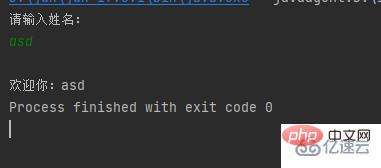
Method 2: JOptionPane If the input content is confirmed, the string value will be nullpublic class a {
public static void main(String[] args) {
String w = JOptionPane.showInputDialog("請(qǐng)輸入詞匯:");
System.out.println(w);
}}Result: 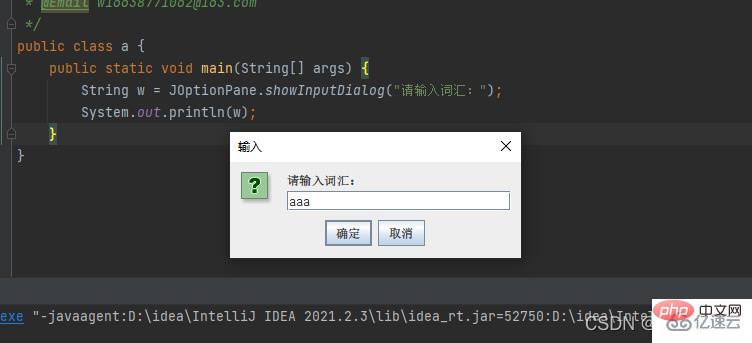

Three ways to output on the consoleMethod 1: System.out.print (); Output to the console
Method 2: System.out.println(); Output to the console and wrap
Method 3: System.out.printf(); Format the output to the console
Code demonstration:
The first method outputs directly without line breakspublic class a {
public static void main(String[] args) {
int w = 1;
int a = 2;
System.out.print(w);
System.out.print(a);
}}Result:
The second line feed outputpublic class a {
public static void main(String[] args) {
int w = 1;
int a = 2;
System.out.println(w);
System.out.println(a);
}}Result:
The third formatted outputResult:The meaning of %d It is an int type variable, that is, replace the first %d with the value of w, and replace the second %d with the value of a
public class a { public static void main(String[] args) { int w = 1; int a = 2; System.out.printf("w=%d a=%d", w, a); }}

Branch statement
if else
if() The condition in the brackets returns true as long as it is correct, and false if it is wrong.else means otherwise
public class a { public static void main(String[] args) { if (1>2){ System.out.println("A"); }else { System.out.println("B"); } }}
Multiple judgments are as follows: If the first judgment is incorrect, the next judgment will be made. When the return value is true, it will be executed, otherwise else## will be executed.switch case default#
public class a { public static void main(String[] args) { if (1 > 2) { System.out.println("A"); } else if (1 > 0) { System.out.println("B"); } else { System.out.println("C"); } }}
#switch multi-branch switch statement
switch(w) w in brackets is the judgment parameter, and the number after case is A value that matches w. When the value of w matches the value after the case, the statement in the current case is executedbreak means to exit the current judgment, which means that there is no need to judge again later
default means the default value, when there is no match The default is thispublic class a { public static void main(String[] args) { int w=1; String wk = ""; switch (w) { case 2: wk = "星期一"; break; case 3: wk = "星期二"; break; case 4: wk = "星期三"; break; case 5: wk = "星期四"; break; case 6: wk = "星期五"; break; case 7: wk = "星期六"; break; default: wk = "星期日"; break; } System.out.println(wk); }}result:
 Loop statement
Loop statement
for
for ( int i = 0; i < 5; i ) is divided into three parts. int i=0 is the initial value, i<5 is the loop condition, and i is the value of i plus 1 after executing this statement once. Exit the loop when i>5public class a {
public static void main(String[] args) {
for (int i = 0; i < 5; i++) {
System.out.println(i);
}
}} Result: 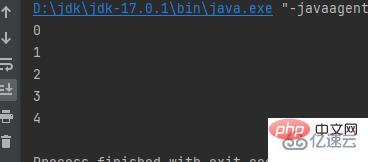 for in
for in
public class a {
public static void main(String[] args) {
int[] a = {1, 2, 3, 4, 5};
for (int i : a) {
System.out.println(i);
}
}}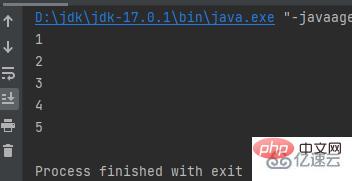 while do while
while do while
while(condition){ }
- Execute the statement if the condition is met, exit if not.
public class a { public static void main(String[] args) { int i = 0; while (i < 5) { i++; System.out.println(i); } }}Result:
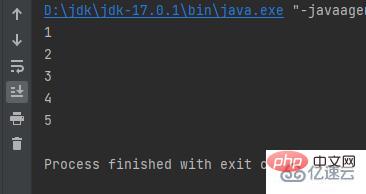
Different from while, do while is executed once Then judgeThe output is executed first and then judged. Therefore, the condition i<0 can also output once
public class a { public static void main(String[] args) { int i = 0; do { i++; System.out.println(i); } while (i < 0); }}
The result is:
 break continue
break continue
break;Skip this time when i is divisible by 2 , proceed to the next cycle. When i is greater than 10, the loop ends.Terminate the current loop statement continue;
End this loop and immediately prepare to start the next loopint i = 0;while (++i < 20) { if (i % 2 == 0) continue; System.out.println(i); if (i > 10) break;}
The above is the detailed content of JAVA process control is implemented in this way. For more information, please follow other related articles on the PHP Chinese website!

Hot AI Tools

Undress AI Tool
Undress images for free

Undresser.AI Undress
AI-powered app for creating realistic nude photos

AI Clothes Remover
Online AI tool for removing clothes from photos.

Clothoff.io
AI clothes remover

Video Face Swap
Swap faces in any video effortlessly with our completely free AI face swap tool!

Hot Article

Hot Tools

Notepad++7.3.1
Easy-to-use and free code editor

SublimeText3 Chinese version
Chinese version, very easy to use

Zend Studio 13.0.1
Powerful PHP integrated development environment

Dreamweaver CS6
Visual web development tools

SublimeText3 Mac version
God-level code editing software (SublimeText3)

Hot Topics
 How to iterate over a Map in Java?
Jul 13, 2025 am 02:54 AM
How to iterate over a Map in Java?
Jul 13, 2025 am 02:54 AM
There are three common methods to traverse Map in Java: 1. Use entrySet to obtain keys and values at the same time, which is suitable for most scenarios; 2. Use keySet or values to traverse keys or values respectively; 3. Use Java8's forEach to simplify the code structure. entrySet returns a Set set containing all key-value pairs, and each loop gets the Map.Entry object, suitable for frequent access to keys and values; if only keys or values are required, you can call keySet() or values() respectively, or you can get the value through map.get(key) when traversing the keys; Java 8 can use forEach((key,value)->
 Java Optional example
Jul 12, 2025 am 02:55 AM
Java Optional example
Jul 12, 2025 am 02:55 AM
Optional can clearly express intentions and reduce code noise for null judgments. 1. Optional.ofNullable is a common way to deal with null objects. For example, when taking values ??from maps, orElse can be used to provide default values, so that the logic is clearer and concise; 2. Use chain calls maps to achieve nested values ??to safely avoid NPE, and automatically terminate if any link is null and return the default value; 3. Filter can be used for conditional filtering, and subsequent operations will continue to be performed only if the conditions are met, otherwise it will jump directly to orElse, which is suitable for lightweight business judgment; 4. It is not recommended to overuse Optional, such as basic types or simple logic, which will increase complexity, and some scenarios will directly return to nu.
 Comparable vs Comparator in Java
Jul 13, 2025 am 02:31 AM
Comparable vs Comparator in Java
Jul 13, 2025 am 02:31 AM
In Java, Comparable is used to define default sorting rules internally, and Comparator is used to define multiple sorting logic externally. 1.Comparable is an interface implemented by the class itself. It defines the natural order by rewriting the compareTo() method. It is suitable for classes with fixed and most commonly used sorting methods, such as String or Integer. 2. Comparator is an externally defined functional interface, implemented through the compare() method, suitable for situations where multiple sorting methods are required for the same class, the class source code cannot be modified, or the sorting logic is often changed. The difference between the two is that Comparable can only define a sorting logic and needs to modify the class itself, while Compar
 How to fix java.io.NotSerializableException?
Jul 12, 2025 am 03:07 AM
How to fix java.io.NotSerializableException?
Jul 12, 2025 am 03:07 AM
The core workaround for encountering java.io.NotSerializableException is to ensure that all classes that need to be serialized implement the Serializable interface and check the serialization support of nested objects. 1. Add implementsSerializable to the main class; 2. Ensure that the corresponding classes of custom fields in the class also implement Serializable; 3. Use transient to mark fields that do not need to be serialized; 4. Check the non-serialized types in collections or nested objects; 5. Check which class does not implement the interface; 6. Consider replacement design for classes that cannot be modified, such as saving key data or using serializable intermediate structures; 7. Consider modifying
 How to handle character encoding issues in Java?
Jul 13, 2025 am 02:46 AM
How to handle character encoding issues in Java?
Jul 13, 2025 am 02:46 AM
To deal with character encoding problems in Java, the key is to clearly specify the encoding used at each step. 1. Always specify encoding when reading and writing text, use InputStreamReader and OutputStreamWriter and pass in an explicit character set to avoid relying on system default encoding. 2. Make sure both ends are consistent when processing strings on the network boundary, set the correct Content-Type header and explicitly specify the encoding with the library. 3. Use String.getBytes() and newString(byte[]) with caution, and always manually specify StandardCharsets.UTF_8 to avoid data corruption caused by platform differences. In short, by
 JavaScript Data Types: Primitive vs Reference
Jul 13, 2025 am 02:43 AM
JavaScript Data Types: Primitive vs Reference
Jul 13, 2025 am 02:43 AM
JavaScript data types are divided into primitive types and reference types. Primitive types include string, number, boolean, null, undefined, and symbol. The values are immutable and copies are copied when assigning values, so they do not affect each other; reference types such as objects, arrays and functions store memory addresses, and variables pointing to the same object will affect each other. Typeof and instanceof can be used to determine types, but pay attention to the historical issues of typeofnull. Understanding these two types of differences can help write more stable and reliable code.
 Java method references explained
Jul 12, 2025 am 02:59 AM
Java method references explained
Jul 12, 2025 am 02:59 AM
Method reference is a way to simplify the writing of Lambda expressions in Java, making the code more concise. It is not a new syntax, but a shortcut to Lambda expressions introduced by Java 8, suitable for the context of functional interfaces. The core is to use existing methods directly as implementations of functional interfaces. For example, System.out::println is equivalent to s->System.out.println(s). There are four main forms of method reference: 1. Static method reference (ClassName::staticMethodName); 2. Instance method reference (binding to a specific object, instance::methodName); 3.
 What is the 'static' keyword in Java?
Jul 13, 2025 am 02:51 AM
What is the 'static' keyword in Java?
Jul 13, 2025 am 02:51 AM
InJava,thestatickeywordmeansamemberbelongstotheclassitself,nottoinstances.Staticvariablesaresharedacrossallinstancesandaccessedwithoutobjectcreation,usefulforglobaltrackingorconstants.Staticmethodsoperateattheclasslevel,cannotaccessnon-staticmembers,






